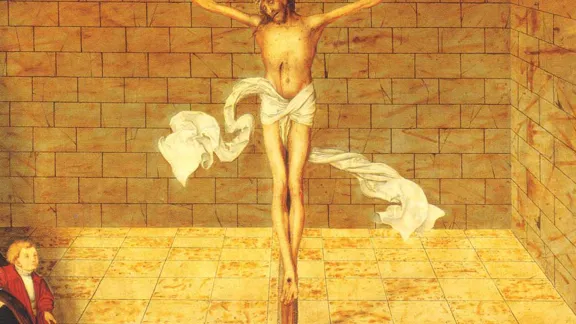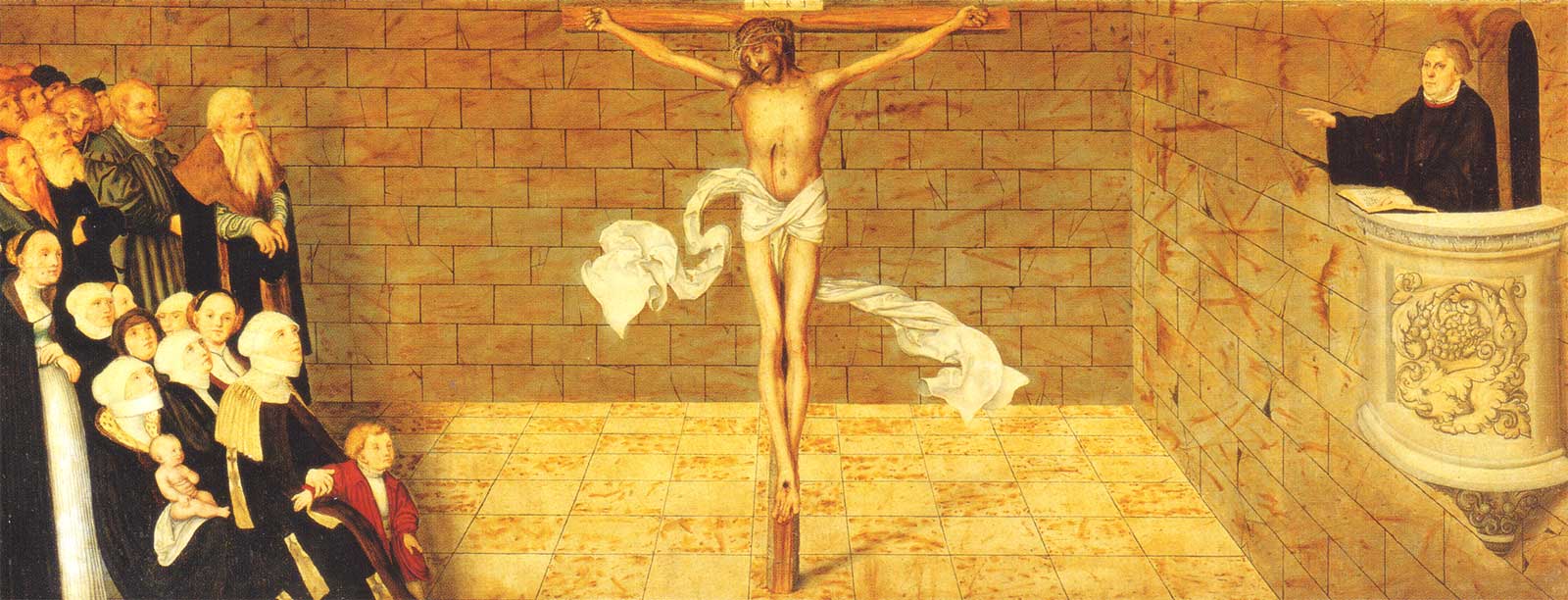
Altarpiece by Lucas Cranach the Elder in the City Church in Wittenberg. (Public domain)
A reflection on three aspects of a preacher and preaching
Lutherans understand that the preached Word of God (viva vox evangelii – the living word of the gospel) is essential for the life of the church. Echoing the apostle Paul’s understanding that “faith comes through hearing” (Romans 10:17), preaching underscores the importance of both the interpretation and proclamation of Scripture for the edification of the community.
But how did Luther preach the word of God?
The famous sixteenth-century painting by Lucas Cranach that depicts Martin Luther preaching offers important clues that help us respond to this question. The painting is a graphic representation of Luther’s hermeneutics (the understanding of the Bible) and homiletics (the art of preaching).
I want to highlight three aspects.
Grounded in Scripture
In the Cranach painting, we see Luther standing in the pulpit delivering a sermon. His left hand is placed on an open Bible below him. Interestingly, Luther is not looking at the Bible. The painting shows a confident preacher, fully in touch with the Bible. His hand is placed on it, suggesting that he is fully grounded in it. Yet Luther was not confined to the Bible. In the painting, he is looking elsewhere, outward. (I will say more about this below.)

There are strong statements in these few details. Luther understood that preaching needs to be in close touch and fully grounded in Scripture. However, he also knew that it must lift the Word of God out of the book and bring it to life, have that word speaking anew and relating it to the community. Preaching is not about repeating the words of Scripture, which one can read anyway. Preaching is about interpreting these words in the current context.
Pointing to Christ
With his right hand, Luther is pointing to the crucified Christ. Christ is at the very center of the painting, attracting the full attention of the observer. Cranach wants Christ to be seen first – as does Luther. To the left of Christ, taking center stage, one sees the congregation. Luther is on the right. Note that Luther is the figure who takes up the least space in the painting, even less space than the community.
Here, too, there are clear messages about how Luther understood the art of preaching. It should be all about Christ! Preaching the Word of God is intentional, it has an “agenda.” It is about interpreting the written word as we know it from Scripture, and directing it to the Word of God, as God spoke it -- to Jesus Christ.
A sermon is not an event in and of itself. Its aim is to make Christ a living event through the work of the Holy Spirit, so that the listeners can comprehend the good news of salvation and liberation as news intended for their own lives.
Secondly, by placing Christ at the center and by depicting Luther at the margin of the painting, a clear message is conveyed -- preaching can never be about the preacher but must always be about Christ! A sermon is not meant to put the preacher on the scene, but about putting Christ in the picture. A sermon is not an event in and of itself. Its aim is to make Christ a living event through the work of the Holy Spirit, so that the listeners can comprehend the good news of salvation and liberation as news intended for their own lives. Or, to keep with the symbol used in the painting, a sermon is not meant to be the preacher’s show, it is about the preacher helping to show Christ.
What “drives” Christ is what guides the way Lutherans read the Bible. Rather than getting lost in the millions of words in the texts, Lutherans read these words asking how they point us to, and speak about, the one through whom God chose to be revealed in fullness – Jesus Christ.
This relationship between Scripture and Christ is key. In Lutheran theology and praxis, “sola Scriptura” and “solus Christus” should never be isolated as stand-alone concepts. When “sola Scriptura” loses sight of “solus Christus,” we end up with blind literalism and fundamentalism, a poor eclecticism that chooses what it wants to read. It risks missing the message of Christ. And “solus Christus” that doesn’t root itself in “sola Scriptura” will end up creating our own gods instead of acknowledging God as our Creator speaking to us through Scripture in both the law and the gospel.
Engaging the community
This leads then to the third message that the painting conveys. It shows Luther facing his community.
Again, there is an important element to bear in mind here. Because Luther knows Scripture well, he doesn’t have to fix his eyes on it, or be so focused on it that he loses contact with his congregation. While bringing the written word to life, Luther also doesn’t have to look at Christ, whose act of salvation his faith has already fully apprehended (sola Fide). Instead, he looks at those who are meant to be reached and transformed through the preached word, the people of God.
Here, too, we get an important lesson of Lutheran understanding of preaching. It is in facing the community, looking at it and engaging with it, that God’s word comes alive and reveals its power of transformation. In order to get the community to encounter Christ, the preacher must be in touch with the community, see it, understand the issues, the questions, the pains and the joys the community is experiencing. There is no place for self-referential preaching, detached from the audience. Preaching is a deeply pastoral action whose primary concern is the lives of the people and what faith in Christ may mean to them. The written word that dates back centuries comes alive, is the “viva vox evangelii” for the people of today.
This then, underlines the importance of preaching in the life of the church and reminds us of the importance of a well prepared sermon.
In a nutshell
In summary, this is how Luther understood preaching – that it should be grounded in Scripture, pointing toward Christ and facing the people. To preach is to put the people in touch with the message of salvation in Jesus Christ as testified in Scripture. And thus, the message will be one of life, of freedom and of hope, focusing on the good news of justification by grace through faith alone: we receive new life to serve God and our neighbor, not because of who we are and what we do, but because of who God is and what God does through Christ.
Biographical info
Rev. Dr Martin Junge is General Secretary of The Lutheran World Federation (LWF). He is an ordained pastor of the Evangelical Lutheran Church in Chile.


